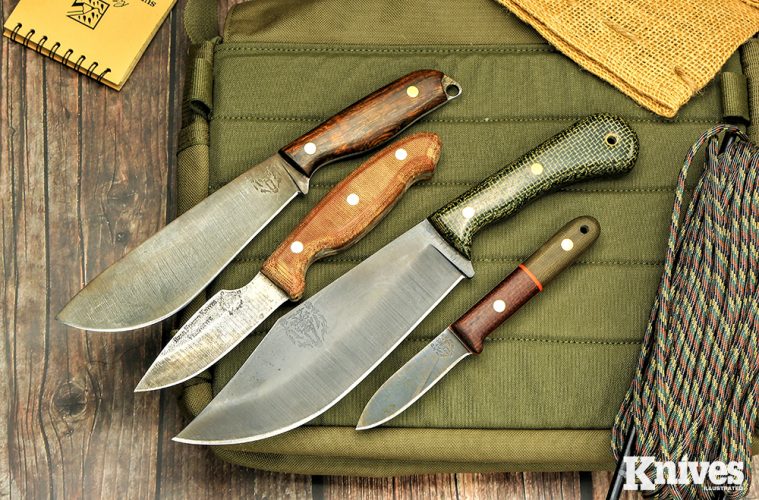THE BEAR FOREST KNIVES AMERICAN-MADE LINEUP PROVIDES LOTS OF PRACTICAL UTILITY
Aharpoon-shaped knife? I first became familiar with Bear Forest Knives (BFK) by repeatedly seeing a knife that had a harpoon-shaped blade appear through various online knife venues. That knife ended up being the GT-1 model.
The first knife I received from BFK, in fact, was still marked “Prototype” at the time. It wasn’t long before the next model found its way to me, the GT-3, and that was just the beginning of what was yet to come.
PASSION TO PROFESSION
Garrett Tremblay is the engine behind Bear Forest Knives, based in Palm Desert, California. As a metal fabricator for many years, Garrett made tools for himself and friends to use on camping and hunting trips, which eventually became his passion. Eventually, his passion took over. It seemed a natural progression for him to make the move to becoming a full-time knifemaker and form Bear Forest Knives.
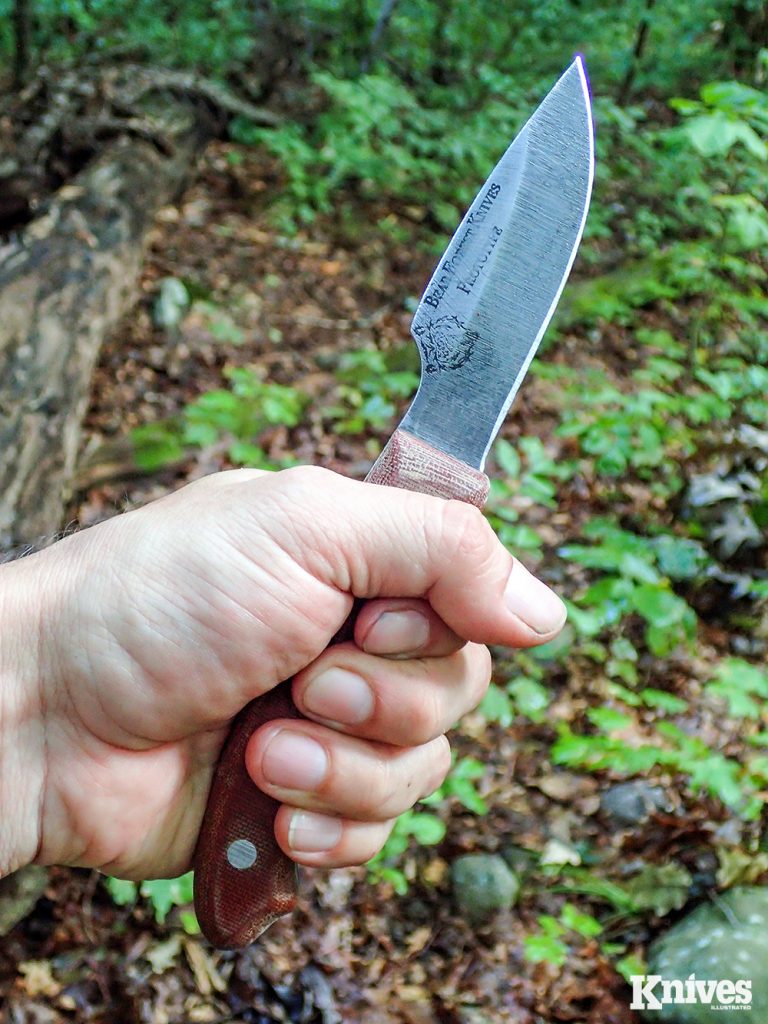
Hand filling and comfortable, the Bear Forest Knives GT1 is suitable for medium to large hands. The contoured and perfectly rounded scales feel like they were meant for long, hard work.
“People seem to gravitate to BFK because the entire supply chain is American made and handcrafted, for one,” Garrett said. “And two, the designs blend traditional practicality with some modern adjustments. BFK walks the line of a trusty, durable adventure tool, with something that makes people also take a second look, I think.”
Garrett uses a variety of high carbon steels, such as 80CrV2, 1095, and 1084.
“I love these steels because of their strength and durability in real world applications, and the ease of re-sharpening,” he said.
THE GT-1
Not only was the GT-1 the first BFK I saw, but it was apparently the one that started the brand. With a 3.6-inch-long blade and overall length of 8.125 inches, it definitely is an all-around sized fixed blade. The thin 0.125-inch-thick 1095 high carbon steel blade had a rustic, tumbled, acid wash finish. The interesting cutout that forms the blade shape was meant to put your thumb on so that it takes a lot of the stress off your thumb when notching and carving.
This cutout section is what gives the GT-1 that original, harpoon-like blade shape. The handle is large, and the scales are very rounded, tan canvas Micarta. The GT-1 handle is the definition of pure comfort one would desire in a tool of any kind.
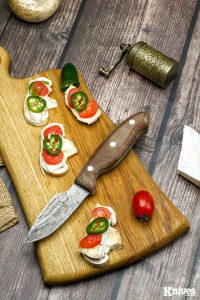
With its nicely curved belly the Bear Forest Knives GT-1 was often called upon for food preparation, even indoors. Here, the GT-1 was used to make a snack after a few months of constant use and no blade sharpening.
I ended up taking the BFK GT-1 with me on overnight camping trips and mushroom forages. Naturally, it did double duty as the food preparation and fire-making knife, which it pulled off well. The thin, sharp grind was especially receptive to wood when shaving tinder as well as slicing vegetables.
The pronounced curve of the blade (belly) made it a pleasure to cut food from a standing position on my low camp table. This would have been harder with a flat blade as I eventually found out.
I am a mushroom addict, and it was mushroom season for oyster mushrooms and the elusive chicken of the woods. As luck would have it, I found some while carrying the BFK GT-1. The blade was just thin enough to carefully slice the ever so valuable chicken of the woods, freeing it from the grass tangle that had been growing into it.
The fun didn’t end there, as the GT-1 was used to slice up the chicken of the woods to make a spicy BBQ mushroom dish. The knife seemed a little handle heavy for my taste, but at the exchange of comfort. Not a bad trade off at all. The grind was still sharp and until this day, I have yet to sharpen it.
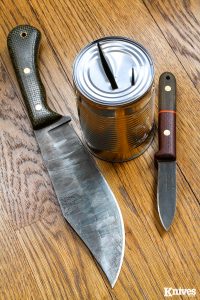
The GT-3 and Wood Butcher stabbed through food cans, which is something one might have to do if a can opener wasn’t available. No damage was done to either blade.
THE GT-3
This knife design is based on Garrett’s go-to bushcraft adventure knife, the ESEE Knives PR4, designed by lead instructor for Randall’s Adventure & Training, Patrick Rollins. Garrett wanted a smaller EDC version of it. After communicating with Patrick and getting the green light, the GT-3 was born.
Spear-point blades have set the tone for general use knives since the days of the Greek sword. The Swiss Army Knife as well as the famed Kephart style knife show just how utilitarian the spear point shape is. I for one am a fan.
Garrett used 1084 high carbon steel for the GT-3 model. Its overall length is 7 inches, with a 3-inch-long blade and a 4-inch handle. The first GT-3 I received had a saber grind, just like the ESEE PR4, and a BFK tumbled acid wash finish.
It also had tan canvas Micarta scales. The sheath was made by Armatus Carry for a select few Bear Forest Knives before Garrett made them himself.
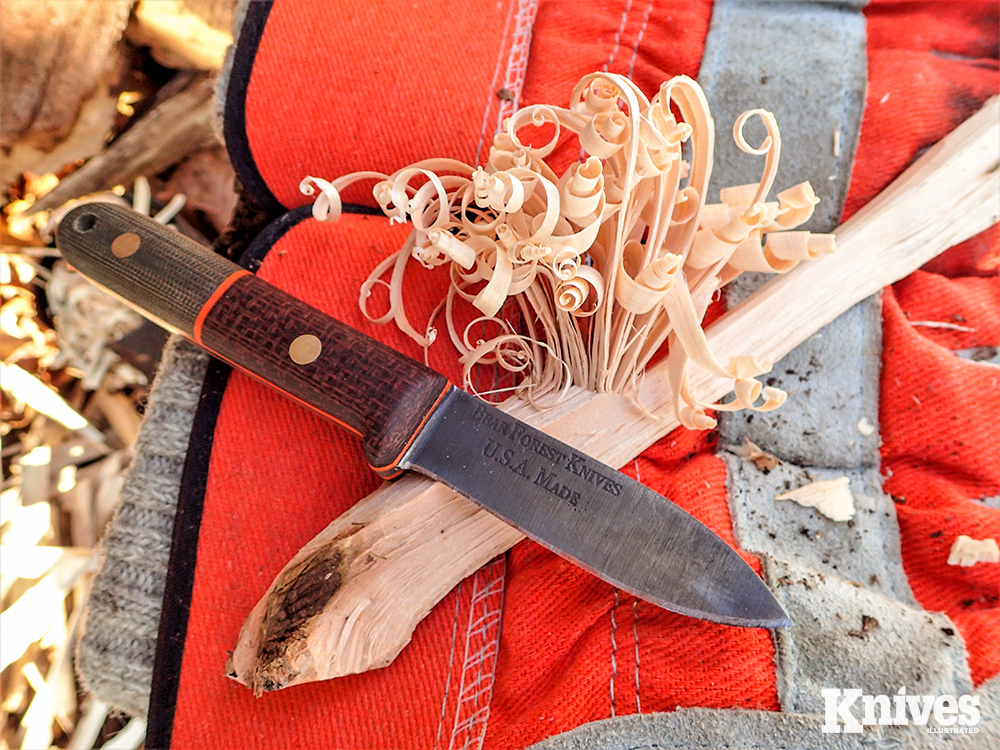
The Bear Forest Knives GT-3 is a crafts knife, made for woods utility. It helped carve utensils and tinder sticks for the author during the winter.
Once I received the BFK GT-3, it was my constant companion, often backing up a tomahawk or large chopping blade, as well as pulling food and utility detail. I carried the GT-3 on a belt loop via a carabiner for easy attaching and removal.
This handy dandy knife was excellent at making notches for tarp stakes and trimming the ends to a chisel point to pound in the ground. It had the most amazing 90-degree spine for scraping poplar tinder and for striking my Uberleben Hexå ferrocerium rods.
This little knife with its 3-inch-long blade just happened to be my favorite sized blade for a camp where there was a bow saw and tomahawk/hatchet. As Horace Kephart said, the sheath knife was always “get-at-able” for quick tasks, which saves the jack knife (folder) from messy work. This was the case with the BFK GT-3.
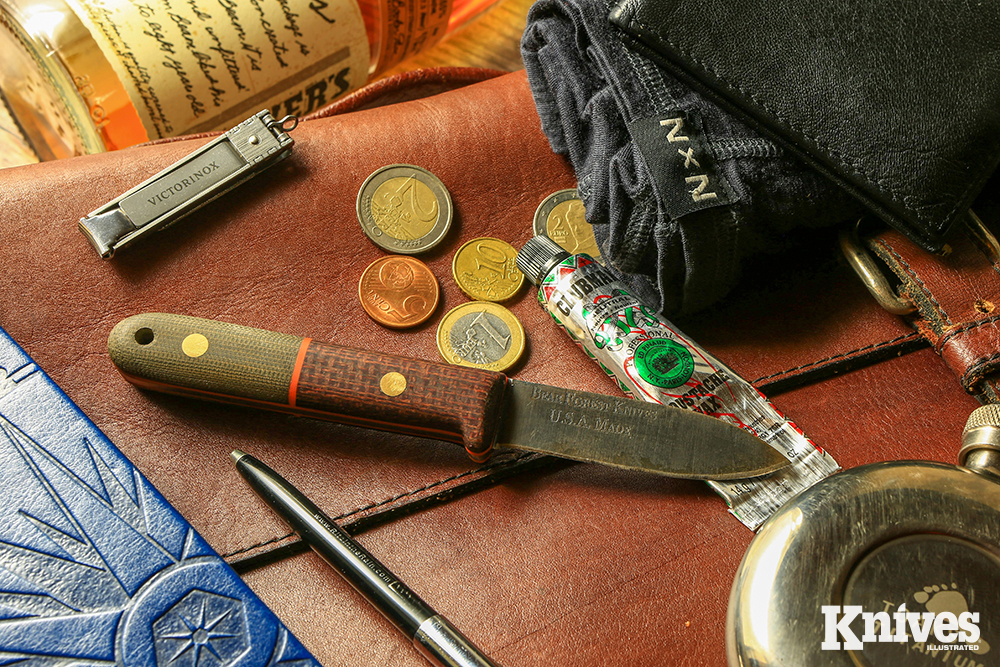
The author considers the Bear Forest Knives GT-3 to be a gentleman’s fixed blade knife. The GT-3 is a very handy, non-obtrusive, nonthreatening knife, just like a gentleman.
At night is when the GT-3 really worked overtime. I keep a charred coffee can in camp full of wood shavings—tinder and kindling sized. I whittled poplar and maple until the can was full. That was the last, yet most important task of the night for the morning’s fire. The BFK GT-3 was always up for the task.
With the autumn season came more mushroom harvesting. This time, oyster mushrooms were harvested with the BFK GT-3. The handle was consistently comfortable, yet the blade needed constant touch ups. Enter the new and improved BFK GT-3.
Garrett made a full-flat ground, 80CRV2 steel GT-3 with black oxide blade finish that was an absolute game-changer. The handle was an astounding combination of burgundy and green burlap Micarta scales, with orange G10 liners. Corby bolts held it all together for a spectacularly strong, appealing, and comfortable knife handle.
I instantly noticed the difference between the full-flat ground edge and the previous saber grind. The same 90-degree spine was there, and it also had the duty of utility at home as EDC and as camp companion this time in winter—more wood shavings to start the wood stove and main campfires, as well as fire starting via the spine on a ferro rod.
Vegetables and Spam for camp kabobs were a necessity, although the flatter blade didn’t process food as well as the curved-style blade of the GT-1.
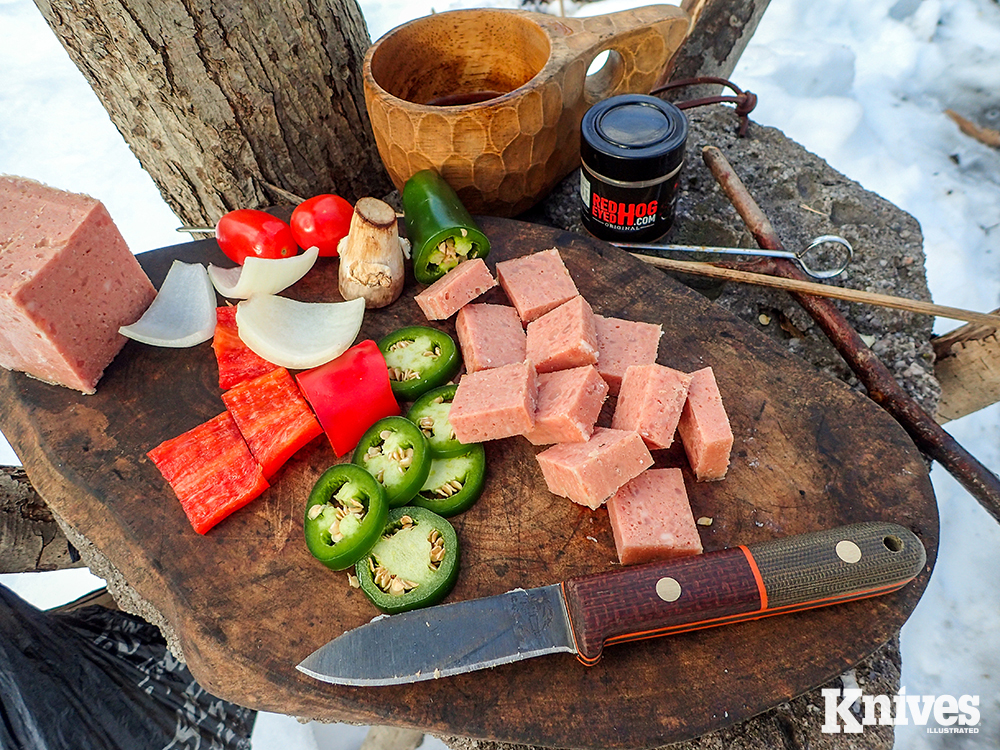
The author’s go-to-meal in camp was kabobs, and the Bear Forest Knives GT-3 did all the prep—including slicing vegetables and chopping wood for the fire.
AMERICAN CLASSIC
Many popular knife patterns over the years have been reproduced by custom knifemakers and major manufacturers alike. The Hudson Bay, Roach Belly, Nessmuk, and Kephart patterns seem to take the lead. I have yet to see many reproductions of the Bowie knife. This is where Bear Forest Knives comes in and gives the Bowie its due.
“Once I received the BFK GT-3, it was my constant companion, often backing up a tomahawk or large chopping blade, as well as pulling food and utility detail.”
Garrett has a passion for Bowie knives.
“Who doesn’t love a beautiful Bowie?” he said. “One of my first knives was a cheap Bowie that my father gave my brother and me (and expected us to share it). Also, I love old Westerns, and who can forget the classic Crocodile Dundee: ‘That’s not a knife; this is a knife.’”
His love for the Bowie shows in his rendition of it—BFK style.
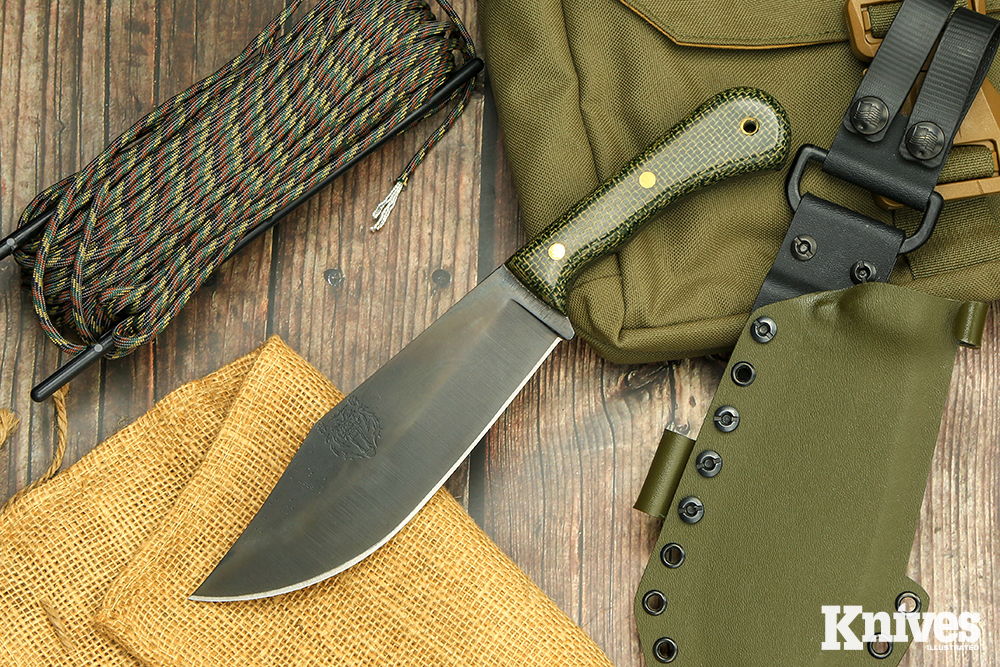
The Wood Butcher is a Bowie inspired knife from Bear Forest Knives. It’s 12 inches long overall with a 7-inch blade, burlap Micarta, and Corby bolts. Its well-fitted, versatile green Kydex sheath features an adjustable fire steel loop and belt loop.
Testing the BFK Bowie, called the Wood Butcher, was done over the course of several weeks using the knife to do most tasks one would have done in the days of old. The Wood Butcher may have been born with wood in mind, but the first thing it had to butcher was chicken.
I wasted no time cleaving through bones and cutting more than 5 pounds of chicken with the Wood Butcher. Also, I was making shredded chicken tacos and Filipino adobo. I wanted exposed bone marrow for added flavor during the long simmering.
The edge stayed sharp and free of nicks throughout. The 7-inch-long blade was similar to using a heavy cleaver, while the 0.187-inch thickness helped as well. It didn’t end there. I made pico de gallo using onions, cilantro, tomatoes, and lime.
The slicing capabilities of the Wood Butcher really shined in the kitchen, but there was still wood to be butchered.
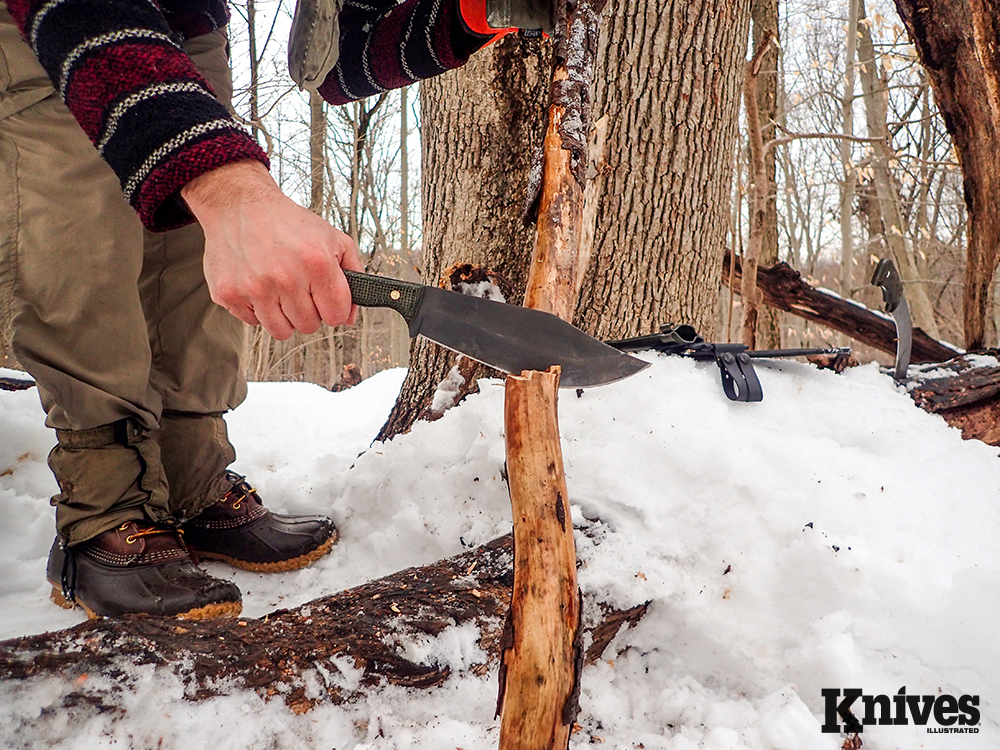
Here, the Bear Forest Knives Wood Butcher lives up to its name. It chopped deep through twisted, dried witchhazel and maple with no issues with edge retention or comfort
With a fresh 3 inches of snow on top of the previous 24 inches that had fallen, the Wood Butcher had one main job—fire. This meant it was getting zero help from the camp hatchet; it would have to do it alone.
A pair of sturdy work gloves and the Bowie went to work, grabbing standing dead limbs of witch-hazel and maple, with some coaxing from the Butcher to free bent over, dry limbs.
I cleared a small workplace in the snow and placed the dry wood on an oak stump, and then began to chop at an angle, rotating the wood. I don’t like to chop with a short-bladed knife, but the Wood Butcher shredded through the dry wood with ease. Naturally, these pieces were full of twisted grain (on the witch-hazel), but still needed to be split.
A stout baton was used to drive the Butcher through the wood, despite the knots and fickle grain. Maple is harder wood, but straighter grained than witch-hazel—mostly. It didn’t seem to matter for the 12-inch-overall knife. It handled these tasks well, without any signs of slowing down the 80CrV2 steel.
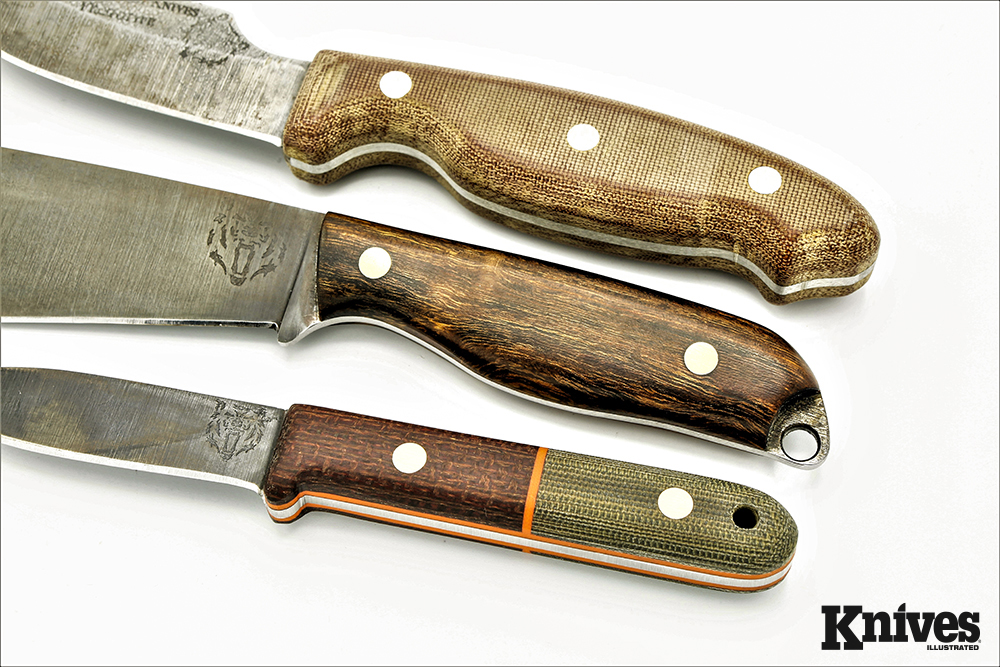
Natural desert ironwood, canvas Micarta, burlap Micarta, and G10 liners are just some materials used by Bear Forest Knives. The desert ironwood used on the Mini Bolo (center), is known for its naturally stabilized qualities and is one of the hardest, most stable woods on earth. It will not shrink or move. Comfort and style, the Bear Forest Knives handles have it all.
Smaller wood processing was even more important than hacking and splitting. The wood needed to be further broken down. I used an icepick grip and a hatchet technique of placing the tip on the end of the wood, farthest from me, and bringing the wood and the blade down on a stump together. A short twist would separate them easily.
I repeated the process until I had small sticks—truly a tedious, necessary act. Only the straightest grained pieces were used to make fuzz sticks for tinder. I used all parts of the blade but seemed to favor the belly to tip portion while bracing the knife against my leg and drawing the wood back against the blade.
“Bear Forest Knives offer hardworking knives made in the USA for hardworking people.”
I made several stakes for my tarp by doing it the simple way. Then, I hacked a straight 90 degree, then about 10 inches down I chopped a steep angle to make a chisel end for the basic shape.
I lightly chopped a stop cut into the top portion and used the blade to carve out a simple notch. A little bit of chamfering the top section to prevent too much splitting and mushrooming was the last step for the stakes—job done.
The Bowie design is timeless and iconic, just as Garrett proclaimed. His blade shape, weight, and uber comfortable handle make this not only a Bowie revamp, but a classic in its own right.
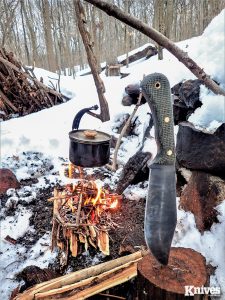
The Bear Forest Knives Wood Butcher in the author’s winter camp. Wood and cooking stew were all processed with the Wood Butcher.
HARD-WORKING KNIVES
Bear Forest Knives offers hardworking knives made in the USA for hardworking people. Garrett’s choice in materials for scales, sheaths, and blade steels are top notch. BFK truly are adventure tools, built to last. I’ve seen some new BFK designs already in the works and caught a glimpse into Garrett’s future and I for one can say—it’s bright.
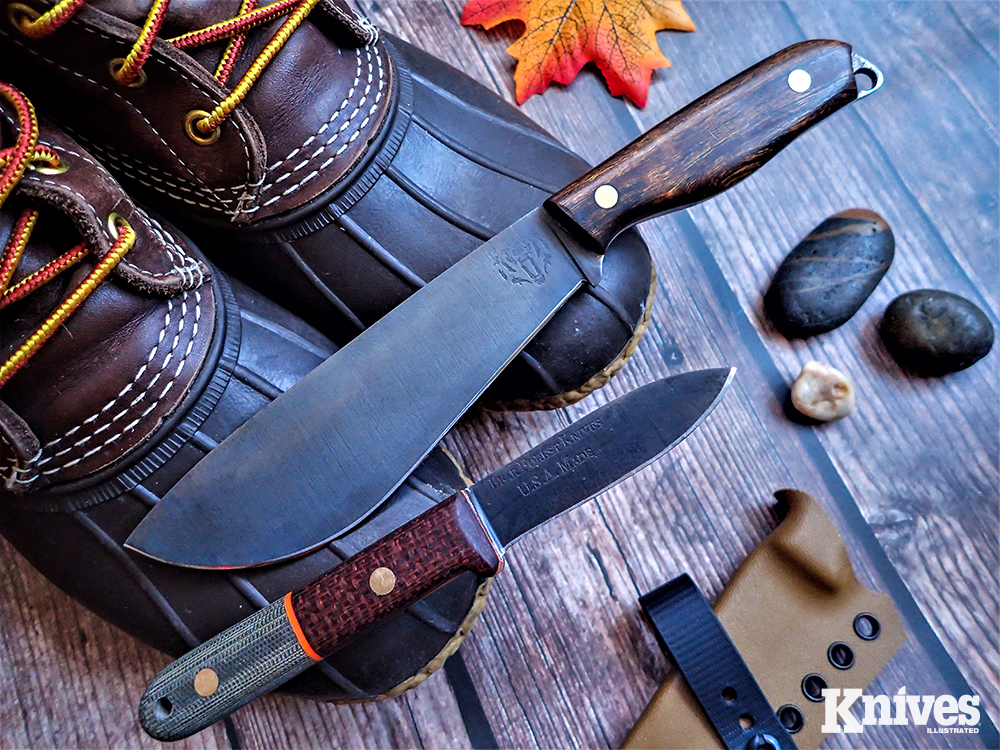
Mini Bolo and GT-3 from Bear Forest Knives, two stunning knives, both in function and appearance. The weight forward bolo design has been put in a smaller package. The GT-3 is a scaled down version of the ESEE Knives PR4.
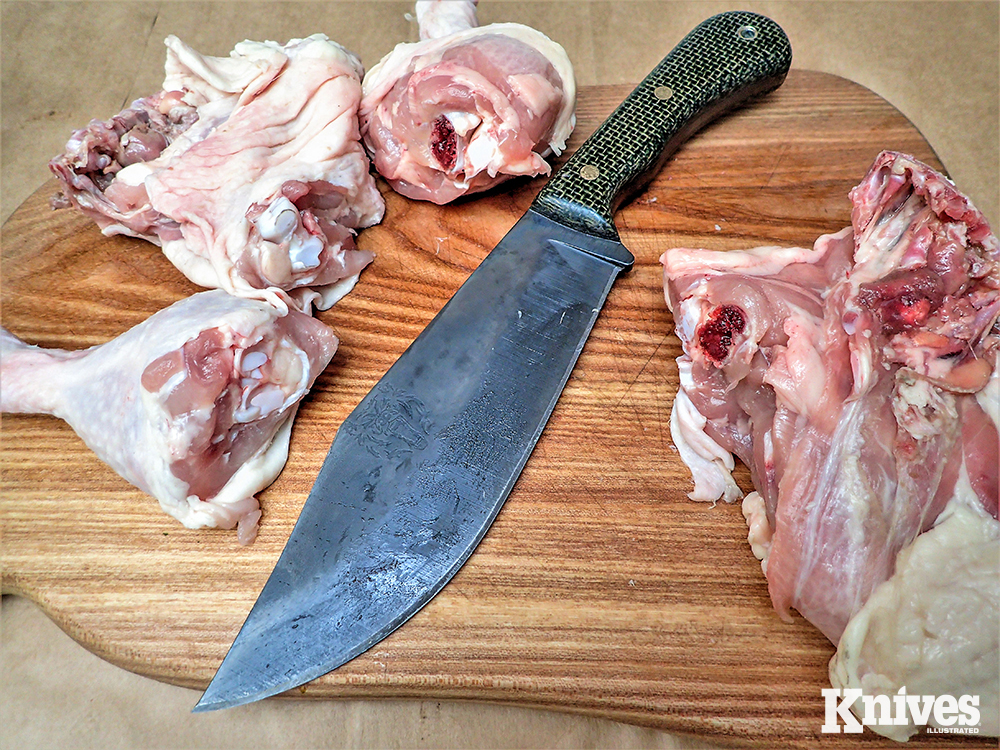
Butchering chicken for various meals, the author put the Bear Forest Knives Wood Butcher through some kitchen tests. No harm was done to the cutting edge throughout the bone chopping.
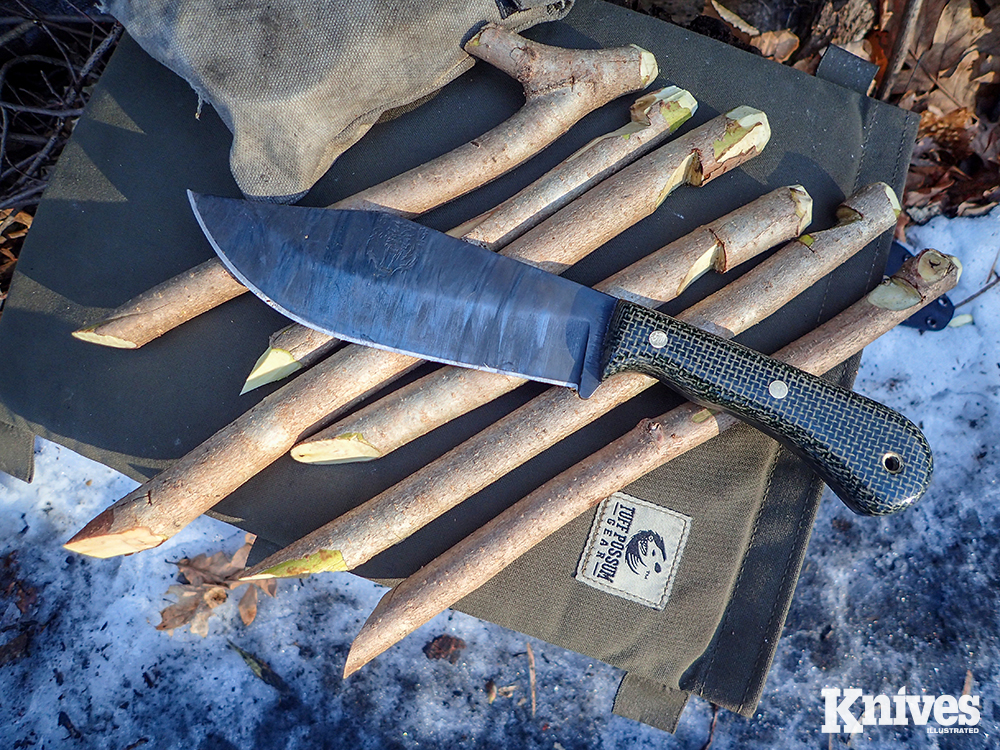
Several tarp stakes were made with the Wood Butcher for tarps and anything needed to be pegged down in deep snow. This is a fast, easily made stake with a chisel end chopped with the knife and a simple stake notch.
The Bowie Knife
Created by James Black in the early 19th century for Jim Bowie, the large fixed-blade patterned knife is iconic to say the least. One characteristic of Bowie knives is the clip point at the top of the blade, which brings the tip of the blade lower than the spine and in line with the handle for better control during thrusting attacks.
As the goal is to produce a sharp, stabbing point, most Bowie knives have a bevel ground along the clip, typically one-quarter of the way, but sometimes much farther, running the entire top-edge. This is referred to as a false edge.
The Bowie knife’s design also lends itself to use as a hunting knife for skinning or butchering game. The curved top clip bevel of the blade, when suitably sharpened, may be used to remove the skin from a carcass, while the straight portion of the blade edge, toward the guard, can be used for cutting meat.
SPECS
GT-1
Overall Length: 8.125 inches
Cutting Edge Length: 3.625 inches
Thickness: 1/8 inch
Steel: 1095 high carbon
Finish: Tumbled acid wash
Handle Scales: Canvas Micarta
Sheath: Kydex
Origin: USA
MSRP: $169.99
GT-3
Overall Length: 7 inches
Blade Length: 3 inches
Thickness: 0.125 inch
Steel: 80crv2 high carbon
Grind: Saber/flat
Finish: Tumbled acid wash
Handles: Canvas Micarta
Sheath: Kydex
Origin: USA
MSRP: $149.99
Wood Butcher
Overall Length: 12 inches
Blade Length: 7 inches
Thickness: 0.187 inch
Steel: 80CrV2 high carbon
Grind: Saber
Finish: Tumbled acid wash
Handles: Canvas Micarta
Sheath: Green/black Kydex
Origin: USA
MSRP: $299.99
Mini Bolo
Overall Length: 10 inches
Blade Length: 5.875 inches
Thickness: 0.125 inch
Steel: 1095 high carbon
Grind: Saber
Finish: Worn black oxide
Handles: Desert ironwood
Sheath: Kydex
Origin: USA
MSRP: $229
Editor’s note: A version of this article first appeared in the July – August 2021 print issue of Knives Illustrated.

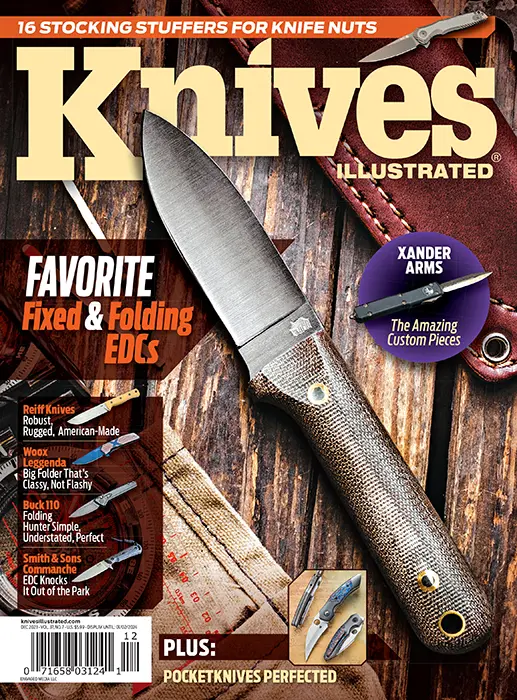 Subscribe / Back Issues
Subscribe / Back Issues